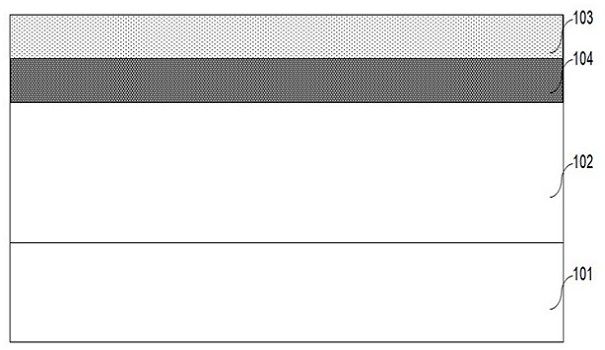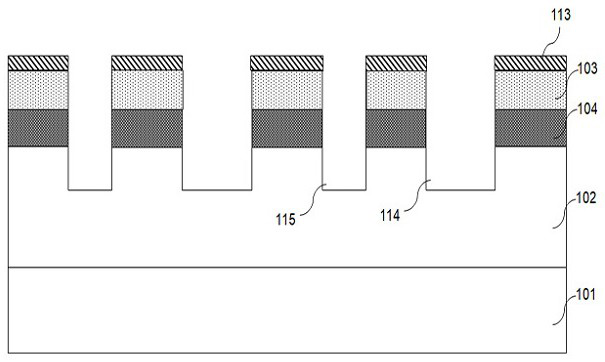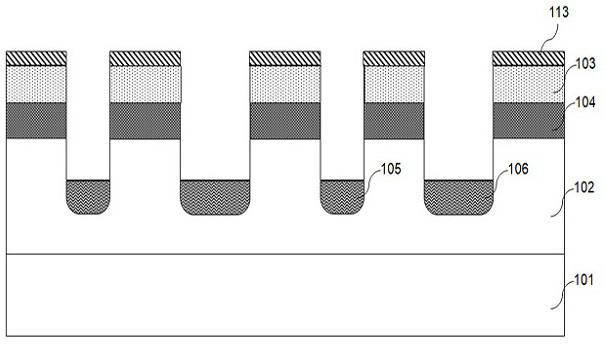High-voltage-resistant silicon carbide device and preparation method thereof
A high-voltage silicon carbide, silicon carbide technology, applied in semiconductor/solid-state device manufacturing, semiconductor devices, electrical components, etc., can solve the problems of complex process, low reverse voltage, etc., to reduce on-resistance, on-resistance reduction, Effect of increasing channel mobility
- Summary
- Abstract
- Description
- Claims
- Application Information
AI Technical Summary
Problems solved by technology
Method used
Image
Examples
Embodiment 1
[0040] Such as Figure 1-5 As shown, taking the first conductivity type as N and the second conductivity type as P as an example, the preparation method of a high-voltage silicon carbide device of the present invention is as follows:
[0041] S1, epitaxial growth on the silicon carbide substrate 101 to form a silicon carbide epitaxial layer 102, specifically as figure 1 shown;
[0042] S2, forming a P-type blocking implantation region 104 on the silicon carbide epitaxial layer 102 by ion implantation of aluminum (Al) or boron (B), with a doping concentration of 5×10 15 cm -3 ~5×10 17 cm -3 , specifically as figure 1 shown;
[0043] S3, forming an N-type source implantation region 103 on the silicon carbide epitaxial layer 102 by implanting nitrogen (N) or phosphorus (P) ions, with a doping concentration of 5×10 16 cm -3 ~1×10 18 cm -3 , specifically as figure 1 shown;
[0044] S4, on the upper surface of the silicon carbide epitaxial layer 102, a patterned mask oxide...
Embodiment 2
[0053] The difference between this embodiment and Embodiment 1 is that the first conductivity type is P, and the second conductivity type is N. Specifically, the preparation method of the high-voltage silicon carbide device is as follows:
[0054] S1, epitaxial growth on the silicon carbide substrate 101 to form a silicon carbide epitaxial layer 102, specifically as figure 1 shown;
[0055] S2, forming an N-type blocking implantation region 104 on the silicon carbide epitaxial layer 102 by implanting nitrogen (N) or phosphorus (P) ions, with a doping concentration of 5×10 15 cm -3 ~5×10 17 cm -3 , specifically as figure 1 shown;
[0056] S3, forming a P-type source implantation region 103 on the silicon carbide epitaxial layer 102 by ion implantation of aluminum (Al) or boron (B), with a doping concentration of 5×10 16 cm -3 ~1×10 18 cm -3 , specifically as figure 1 shown;
[0057] S4, on the upper surface of the silicon carbide epitaxial layer 102, a patterned mask...
PUM
 Login to View More
Login to View More Abstract
Description
Claims
Application Information
 Login to View More
Login to View More - R&D
- Intellectual Property
- Life Sciences
- Materials
- Tech Scout
- Unparalleled Data Quality
- Higher Quality Content
- 60% Fewer Hallucinations
Browse by: Latest US Patents, China's latest patents, Technical Efficacy Thesaurus, Application Domain, Technology Topic, Popular Technical Reports.
© 2025 PatSnap. All rights reserved.Legal|Privacy policy|Modern Slavery Act Transparency Statement|Sitemap|About US| Contact US: help@patsnap.com



